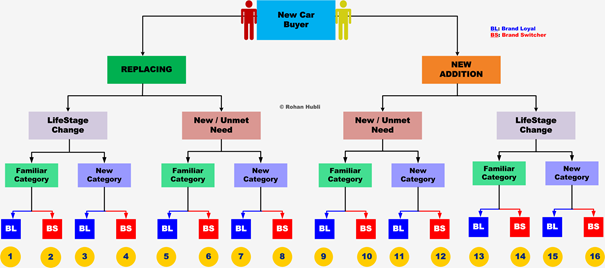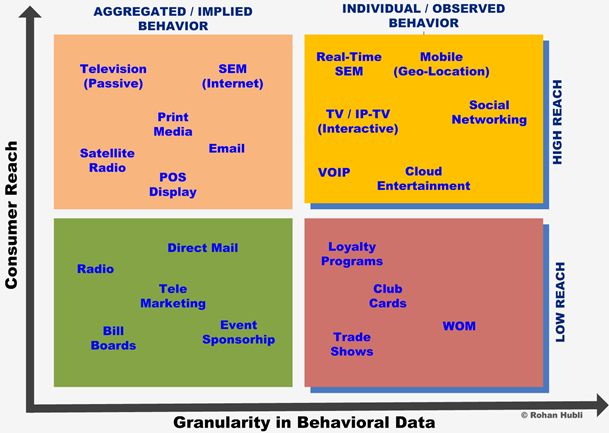“Half Of All Advertising Doesn’t Work, The Trouble Is We Don’t Know Which Half ” still reigns supreme in the world of advertising.
Emerging new technology, shifting consumer behavior, always on consumer touch points and evolving new media are converging to create a new paradigm in advertising.
Advertising – Traditional, SEM, Social Media or Mobile ?
Universally almost all purchase decisions can be categorized into either a High-Involvement Purchase (ex: Home Appliance) or a Low Involvement Purchase (ex: Grocery). The former entails significant risks, is driven by situational needs and involves complex decision making. The latter seeks to minimize time, as Low-Involvement products engulf eighty percent of all purchases, is predisposed to impulse buying and familiarity/awareness plays a key role.
It is no surprise than that most of the advertising (traditional) we see and hear around us encompasses Low-Involvement products.
Then the internet came along and SEM captured the attention of marketers. As a platform Internet offered conversations with and between buyers to be captured and acted on.
The one notable difference – Internet Search is preceded in most cases by a situational need (i.e. most buyers are either looking for something specific or researching a product category). In certain cases an enduring need also finds expression on the internet in the form of Blogs, Chat-Boards, User Forums or Special Interest Groups to name a few.
One could argue that SEM is ideally suited for High-Involvement products, but this does not seem to be the case. There is a reason behind this….. Legacy for one and….Risk Aversion for another.
With Social Networks people share rich information about their lifestyle, habits, interests and needs on an ongoing basis. A new dimension – Individual Behavioral Data is now available to marketers. What we get with Social Network Advertising is a hybrid between traditional and internet advertising.
With Mobile web we are on the cusp of something phenomenal. An ability to bring together all elements from Traditional, SEM and Social Network Advertising in a way unimaginable until now.
The Elusive Target:
According to The 2011 Digital Marketer, Benchmark and Trend Report “The most influential element driving purchase decisions today is still Word of Mouth (54 percent), followed by information from a Website (47 percent).” Advertising in video games and on mobile phones seems to influence far fewer consumers in purchase decisions.
That for you is the dichotomy facing advertisers: How to target advertisements effectively, in what media, to whom, where and when.
Consider the decisions confronting a marketer when trying to influence a new car buyer. Depending on the buyer’s needs and life-stage a simplified decision matrix could yield 16 different options resulting in a specific choice of vehicle make and model.
Traditional means of serving an AD to such a prospective car buyer is a “Hit-or-Miss” game of chance. While Internet Advertising (SEM) added a new level of dimension by tying AD’s to the “search keyword” it is still blind to the prevailing need driving the search.
Critical information on Individual Buyer’s behavior and his or her preferences at various stages in the decision cycle eluded advertisers and advertising platforms. Today this data can be a near certainty.
Out with the Old in with the New:
The Old: The old world of Advertising relied on eyeballs, media concentration, economies of scale, POS data and consumer surveys to create awareness, cultivate brand attitudes and induce purchase intentions.
It did so using a careful selection and allocation of advertising spending across fifteen different media with the aim of maximizing reach and effectiveness.
The New: Platforms today are flush with rich behavioral data on shoppers, their life-style, geo-demographics, touch points and interactions as they happen in real-time.
In addition the incremental cost of delivering an AD impression today in ‘”Real-Time” is nearing “ZERO”. The ramifications are clear, an era of 1-ON-1 advertising is on the cusp.
The new age of advertising is all about capturing rich information flows in real-time within and across media platforms. Economies of scale or leveraging the networks with the largest reach become secondary as fragmentation is the norm.
New Rules of Advertising:
- Multi-homing – New age consumers will move seamlessly between platforms and media– with platform service providers incurring most of the multi-homing costs.
- Spatial vs. Temporal Relevance – The new advertising paradigm is all about harnessing relationships-interactions and developing models that morph information. The frantic bidding to secure the most coveted time slot will lose prominence.
- Real-Time / 1-ON-1 – The era of real-time, personalized on the fly AD delivery is here to stay.
- Ubiquitous Network – AD impression and delivery must traverse the intended target’s choice of platform across the behavioral sequence model.
- AD Markers – Just as DNA holds key genetic information governing humans, so too will AD Markers come to define buyers.
Update Sep-21, 2011: WSJ Article: “TV Lures Ads but Viewers Drop out”



